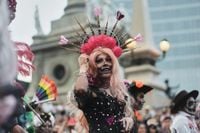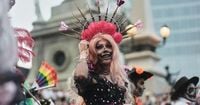Mexico City’s streets burst into a kaleidoscope of color and sound on October 27, 2025, as thousands of revelers gathered for the annual Catrina parade, marking the vibrant start to the city’s Day of the Dead celebrations. Beneath the cloudless sky, a sea of skeletons—some elegant, some playful, all striking—wove through the heart of the capital, their faces painted in iconic calavera style and their costumes shimmering with Mexican folk art traditions.
At the center of this year’s parade was a group determined to make their presence felt: Exóticas, a collective of nearly 200 LGBTQ+ artists, stylists, and designers. Drag artist Ángel Arumir, a 42-year-old veteran of the scene, stood out in a pink mermaid-style dress inspired by Mexican folk art, crowned with flowers atop a vivid purple wig. As he adjusted his crown, Arumir surveyed the crowd, preparing to step into what he describes as “a sea of skeletons”—and into a rare moment of safety and solidarity for Mexico’s LGBTQ+ community.
“This day is our chance to show our art and our hearts with dignity,” Arumir said, reflecting on nearly two decades spent performing in drag. For him and many others, the parade isn’t just a chance to celebrate; it’s a moment to claim space in a society where acceptance often comes at a steep price. “It has been difficult to gain our place in events related to our traditions,” he added, underscoring the long road to visibility and inclusion.
The parade, which has grown into one of Mexico City’s largest pre–Day of the Dead events, featured more than 40 groups representing a mosaic of social causes. Marching alongside Exóticas were mothers demanding justice for Mexico’s disappeared, collectives honoring pre-Hispanic traditions, and fans decked out to celebrate their favorite music genres. Each group brought its own rhythm, color, and message, transforming the city center into a living, breathing tapestry of Mexican identity and activism.
But for Exóticas, the stakes felt especially high. According to Sin Violencia LGTBQ+, a regional network tracking violence against the queer community, more than 80 LGBTQ+ people were murdered in Mexico in 2024 alone—second only to Colombia in Latin America and the Caribbean. Of those, transgender women accounted for 55 deaths. Activist Jair Martínez, part of the network, noted that discrimination has intensified over the past five years as transgender women have become more visible. “Before, many of these women worked in clandestine spaces,” Martínez explained. “Now they have more exposure in public and that could explain why we’ve seen more violence towards them.”
Preparing for the parade is no small feat. For Arumir and his team, it’s a yearlong labor of love, squeezed in between jobs and family responsibilities. They sketch designs, sew costumes, and experiment with makeup, channeling their passion for drag and Mexican symbolism into every detail. Each dress is unique, bursting with vibrant colors and intricate patterns created just for the occasion. Some costumes carry powerful messages—like the outfit worn by Rich González, who traveled from Tijuana to participate. González’s black ensemble, adorned with colorful crosses cascading down the trailing train of a skeleton figure, honors LGBTQ+ community members lost to violence in Tijuana, a city long haunted by cartel conflict.
First-time marcher Santiago Mercado, just 18 years old, described the parade as “a chance to celebrate our culture in a space where we can keep fighting for our rights.” For many, the parade is more than a party—it’s an act of resistance, a statement of existence, and a call for recognition in a country that too often turns a blind eye to violence and discrimination.
The Catrina parade itself is a relatively new tradition, first taking shape in 2014 when makeup artist Jessica Esquivias rallied friends to celebrate Mexican icons and push back against the rising tide of Halloween imagery in local stores. What began as a small circle of creatives showing off their craft has ballooned into a spectacle drawing tens of thousands of participants and spectators to downtown Mexico City each year. The event now stands as a testament to the enduring power of Mexican cultural symbols and the ever-evolving ways people choose to honor them.
The Catrina figure at the heart of these festivities has a history as colorful as the costumes on parade. Born from satire in the early 1900s, the tall skeleton in a feathered hat was first drawn by artist José Guadalupe Posada to mock Mexico’s upper class and its obsession with European elegance. The message was clear: death makes equals of us all, no matter our wealth or status. Over the years, the Catrina has become an enduring emblem of the Day of the Dead, symbolizing both remembrance and defiance.
Today, that spirit of defiance finds fresh meaning in the work of groups like Exóticas. As Arumir and his fellow performers danced to traditional Latino pop songs, the crowd pressed closer, their phones held high and their smiles wide. For a few hours, at least, the city belonged to them—a place where anyone could join and be themselves in freedom and safety. “I want Exóticas to be an inclusive space where anyone can join and be themselves in freedom and safety,” Arumir said, echoing the hopes of many who marched alongside him.
The parade’s inclusivity is hard-won. For years, LGBTQ+ collectives struggled to find acceptance in events tied to Mexico’s deepest traditions. Now, their participation is not only welcomed but celebrated, a sign of shifting attitudes and growing recognition of the diversity within Mexican society. Yet the shadow of violence remains, a sobering reminder of the work still to be done. As Martínez observed, increased visibility can bring both progress and peril.
Still, the mood on parade day was one of hope. Revelers in skeletal face paint and extravagant attire danced, laughed, and remembered those lost—both to time and to violence. The Day of the Dead, after all, is about honoring memory and embracing life, even in the face of mortality. For Exóticas and the thousands who joined them, the parade was a declaration: we are here, we are proud, and we will not be erased.
As the sun set over Mexico City, the echoes of laughter and music lingered in the air, mingling with the scent of marigolds and the promise of another year. The Catrina parade continues to evolve, but at its heart, it remains a celebration of life, death, and the unbreakable spirit of those who refuse to be forgotten.

